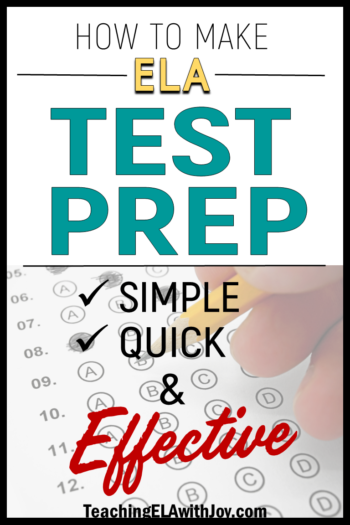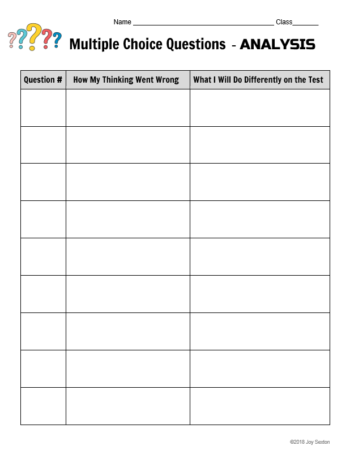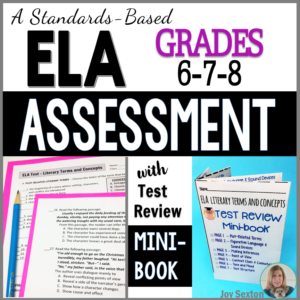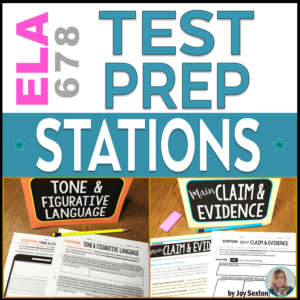
Sometimes I hear teachers say, “I don’t do much test prep with my kids because we practice those skills all year long.” Well, that would be fantastic except for the fact that oftentimes our middle school students don’t retain the information we teach. On top of that, the state assessments, without a doubt, have a history of containing confusing and sometimes tricky content.
So even though we’re embedding our standards week after week, it’s essential to plan a concise Test-Prep Unit. I start mine three weeks before the assessment. Targeted practice with all formats of the test will help your students establish a mindset of readiness and confidence.
First, I like to talk a little about the test itself. I explain the number of days, number of questions by types, and other parameters such as use of technology. Then I explain that our unit relates specifically to success on the exam. It’s a test-taking unit. I want to remind them that strategies need to be used for navigating reading passages and multiple choice questions. I want to clarify that the type of writing they will be doing is “test writing.”
It helps if, during the year, you provide some short constructed response questions based on literature you teach. (Your students probably write these in social studies, too.) That way, students will already be used to this “test-taking” format of response. Same thing goes for using tests with reading passages that require deeper thinking. Remember, the test prep unit should be a review of skills and formats previously learned and practiced.
In this “Part I” of my two-part blog post, you’ll find a free Student Analysis handout you can view and print to use with the reflective part of the lesson. So here’s my quick and effective method to engage students in preparing for multiple choice testing:k
MULTIPLE CHOICE – Our state publishes “released questions” from last year’s assessment. I use two or three of the passages and questions to copy and distribute to students. If you can’t get actual questions used on recent tests, choose passages from other test prep materials you may have. Just make sure the reading is rigorous and they hit a good variety of skills in the questions.
First, provide post-its and let students brainstorm in small groups. Have them list at least three test-taking strategies they know that apply to multiple choice questions. We do a whole-class share and record responses on the front whiteboard or chart paper. Then I pass out the passages, arranged in a stapled packet, and things get quiet. I let students know that they are required to “mark up the text,” at the very least to underline, circle, or highlight key ideas. In addition to circling their answers on the practice test itself, I have students record their answers on a separate sheet of paper to hand in. Of course, someone will ask, “Is this for a grade?” (they always do, right?) I tell them, “Yes, you will get a grade, for effort and participation, so do your best.”
When students finish, they hand in their separate answer sheets. (Independent novels should be within reach for early finishers.) Then, we turn to the packets and focus on one passage at a time. Students are given 6-7 minutes to compare and discuss their answers with a partner. I tell students not to actually change any answers in their packet—but to discuss what they thought was the correct answer and why. Next, we go over the questions together. We talk about strategies students used and why a response may be right or wrong. We always refer back to the text, citing certain lines. Students now mark their answers correct or incorrect.
This whole group discussion time allows many teachable moments where I can alert students to tricks like distractors and review terminology they may have misinterpreted. I (and other students) can “think aloud” our reasoning for arriving at the correct choice. When we finish this process for all three passages, students mark the total number of incorrect answers on the front top corner of the packet. But I tell them not to worry if they didn’t do well!
Finally comes the reflective piece. Students now have an opportunity to “buy back” all their missed points! They will reflect on the questions they missed, explain where they went wrong, and describe what they will do differently on this type of question on the actual test. You can view and print the handout I use for this test prep activity by clicking on the image:
Students complete this process only for the questions they got wrong. By doing so, they now take charge of their learning by examining more closely the skills they tripped up on. I have them turn in this page clipped to the front of their practice packet. When grading, I don’t even look at the original answer sheets I collected. Their purpose was to discourage students from changing any answers in their booklets when discussing with peers. I simply glance at the number of incorrect answers written at the top of the packet and then at their “test corrections.” If students have put effort into explaining their thinking for the questions missed, and state something specific that they will need to do differently, I give them full credit. This entire lesson covers a few class periods for me.
I view the Test Prep as classwork, and feel good about posting a high number of points in my grade book when students fully participate. By working through 2-3 relevant multiple choice selections with partner and whole class discussion, along with student self-analysis, you can provide simple test prep that hits the mark!
In Part II of my Test Prep blog post, I discuss test prep strategies for the Writing sections. You can view that post by clicking this title: Test Prep Ideas for Writing – That Work!
You may like these engaging, no-prep resources to include in your Test Prep unit. Just click on the image to look closer.







Leave a Reply